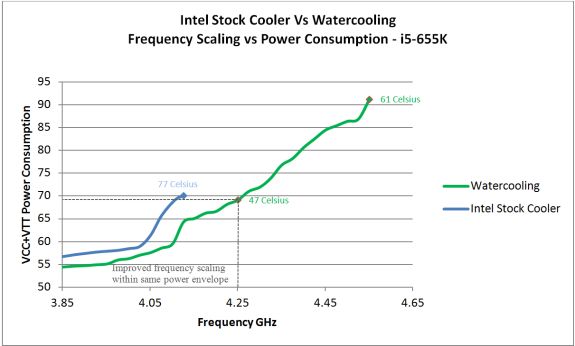Now that we’ve got a couple of baselines out of the way using Intel’s stock heat-sink, it’s time to peg thermals back a bit on and see how the i5-655K substrate responds to lower load temperatures:

Switching over to our water-cooling loop decreases load temperature deltas by up to 35 degrees Celsius on this sample (as reported by on-die DTS). The upshot of this is seen quite clearly in the graph - lower load temperatures decrease processor power consumption at equivalent frequencies due to a positive temperature co-efficient (the hotter the CPU runs the more power it leaks - all else being equal). With the end result being that we’re able to boost our previous 3.77GHz stock VID overclock using the stock Intel cooler by almost 200MHz to 3.953GHz.
The improved thermal dissipation allows us to ramp voltages and takes us all the way to 4.55GHz before we hit the wall of diminishing returns. The demands on voltage ramping past this point are such that we start to see a minimum 5~10 watt rise in power consumption for every 20MHz increase in frequency. Also note, that we’re about 40MHz away from doubling up on stock processor power consumption; 4.25GHz seems to be the sensible operating point, coming in at 16 Watts over stock power draw to VCC and VTT with a 900MHz boost in full-load core frequency - and that’s with all performance related domains overclocked.











51 Comments
View All Comments
Rajinder Gill - Saturday, May 29, 2010 - link
Hi,I ran out of time to test any further unfortunately. The emphasis was kept on air/water cooling because it's practical to run 24/7.
Regards
Raja
TheBLK - Saturday, May 29, 2010 - link
I'll ask again. Unless the screen shots are wrong you used BLK clock to over-clock rather than multiplier on the chip.Other reviews kept the BLK at the same value and just used the multiplier and seemed to get higher results.
Rajinder Gill - Saturday, May 29, 2010 - link
Yes I did on the 655-K stock VID (added 2 BCLK because the next multiplier up was too far (133 multiples in frequency is a large jump) :http://www.anandtech.com/show/3742/intels-core-i56...
Also describe why BCLK overclocking is not the way to go on the 655K for performance:
http://www.anandtech.com/show/3742/intels-core-i56...
Finally the 855K - this chip is limited to 4GHz even on water cooling. BCLK overclocking is not going to change that. 167 BCLK at DDR3 1670 is nowhere near stressful for the Lynnfield IMC. Multiplier overclocking is NOT going to make any difference to the clock speed limitation.
-Raja
Rajinder Gill - Saturday, May 29, 2010 - link
Just for you :)http://img7.imageshack.us/f/linpackfailj.jpg/
That is all the water loop can handle (the chip is drawing over 190W). I can drop the multiplier down to 30 (but then we are back to 4GHz).
Hope this helps!
Regards
Raja
DJMiggy - Thursday, June 3, 2010 - link
It seems like you guys used the wrong motherboard or got a dud i7. Other reviewers don't seem to be having as tough a time overclocking these higher.Rajinder Gill - Friday, June 4, 2010 - link
The motherboard is EVGA's E659 - works fine with my i7 870 ES taking it to 4.4GHz Linpack stable. It's the CPU that is the limiting factor here. Bear in mind that not all articles you've read will have stability checked stability with Linpack as well.Later
Raja
DJMiggy - Friday, June 4, 2010 - link
That makes sense. Cool thanks! I appreciate the explanation.ReaM - Saturday, June 5, 2010 - link
I must say, what a crappy K-series! I can bring every i7 860 up to 4ghz. I have tested many of them, so there is really no reason to put any hope into these Ks. Just buy a regular one.My personal sample of 860 runs @ 4200 with 1.29V on air Noctua U12 with low temps.
ReaM - Saturday, June 5, 2010 - link
Did you put Load Line Calibration into LVL2?I don't know what's that called on EVGA. Enhanced Power Slope. VDrop Adjustment. Lynnfield, unlike Bloomfield, likes their load line to be adjusted.
Rajinder Gill - Sunday, June 6, 2010 - link
Makes no difference to the stability of this chip.